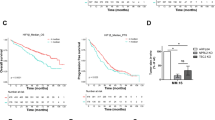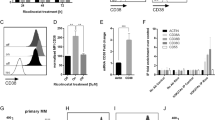Abstract
We recently demonstrated that the mammalian target of rapamycin (mTOR) inhibitor, CCI-779, curtailed the growth of a subcutaneous challenge of multiple myeloma (MM) cells in immunodeficient mice. This antitumor effect was associated with prevention of cell proliferation, induction of apoptosis and inhibition of angiogenesis. Interestingly, myeloma tumors with heightened AKT activation were particularly sensitive to a CCI-779-induced antitumor response. To investigate whether part of the differential sensitivity was due to an AKT-regulated effect on angiogenesis, we compared the effects of mTOR inhibitors against isogenic MM cell lines that only differ by their degree of AKT activity. In this model, heightened AKT activity significantly sensitized MM cells to the following inhibitory effects of mTOR inhibition: angiogenesis in vivo, vascular endothelial growth factor (VEGF) expression in vitro and in vivo and VEGF translation (but not transcription). Assessment of p70S6 kinase activity indicated that rapamycin induced comparable mTOR inhibition in both cell lines suggesting that an adverse effect on VEGF cap-dependent translation would be comparable. Internal ribosome entry site (IRES)-mediated cap-independent translation is a salvage pathway for protein expression when mTOR is inhibited, so we analyzed a possible regulatory role of AKT on VEGF IRES activity. We found that elevated AKT activity inhibited VEGF IRES function. These results support a mechanism whereby AKT prevents VEGF IRES activity in myeloma cells during mTOR inhibition resulting in a more complete abrogation of VEGF translation, and ultimately, angiogenesis.
This is a preview of subscription content, access via your institution
Access options
Subscribe to this journal
Receive 50 print issues and online access
$259.00 per year
only $5.18 per issue
Buy this article
- Purchase on Springer Link
- Instant access to full article PDF
Prices may be subject to local taxes which are calculated during checkout






Similar content being viewed by others
References
Akiri G, Nahari D, Finkelstein Y, Le SY, Elroy-Stein O, Levi BZ . (1998). Regulation of vascular endothelial growth factor (VEGF) expression is mediated by internal initiation of translation and alternative initiation of transcription. Oncogene 17: 227–236.
Bellamy WT, Richter L, Frutiger Y, Grogan TM . (1999). Expression of vascular endothelial growth factor and its receptors in hematopoietic malignancies. Cancer Res 59: 728–733.
Berra E, Diaz-Meco MT, Moscat J . (1998). The activation of p38 and apoptosis by the inhibition of Erk is antagonized by the phosphoinositide 3-kinase/Akt pathway. J Biol Chem 273: 10792–10797.
Bert AG, Grepin R, Vadas MA, Goodall GJ . (2006). Assessing IRES activity in the HIF-1α and other cellular 5′ UTRs. RNA 2: 1074–1083.
Bjornsti MA, Houghton PJ . (2004). The TOR pathway: a target for cancer therapy. Nat Rev Cancer 4: 335–348.
Chesi M, Nardini E, Brents LA, Schrock E, Ried T, Kuehl WM et al. (1997). Frequent translocation t(4;14)(p16.3;q32.3) in multiple myeloma is associated with increased expression and activating mutations of fibroblast growth factor receptor 3. Nat Genet 16: 260–264.
Dankbar B, Padro T, Leo R, Feldmann B, Kropff M, Mesters RM et al. (2000). Vascular endothelial growth factor and interleukin-6 in paracrine tumor-stromal cell interactions in multiple myeloma. Blood 95: 2630–2636.
Evans JR, Mitchell SA, Spriggs KA, Ostrowski J, Bomsztyk K, Ostarek D et al. (2003). Members of the poly (rC) binding protein family stimulate the activity of the c-myc internal ribosome entry segment in vitro and in vivo. Oncogene 22: 8012–8020.
Frost P, Moatomed F, Hoang B, Shi Y, Gera J, Yan H et al. (2004). In vivo anti-tumor effects of the mTOR inhibitor, CCI-779, against human multiple myeloma cells in a xenograft model. Blood 104: 4181–4187.
Gera JF, Mellinghoff IK, Shi Y, Rettig MB, Tran C, Hsu JH et al. (2004). AKT activity determines sensitivity to mTOR inhibitors by regulating cyclin D1 and c-myc expression. J Biol Chem 279: 2737–2746.
Hideshima T, Nakamura N, Chauhan D, Anderson KC . (2001). Biologic sequelae of interleukin-6 induced PI3-K/Akt signaling in multiple myeloma. Oncogene 20: 5991–6000.
Hsu J, Shi Y, Krajewski S, Renner S, Fisher M, Reed JC et al. (2001). The AKT kinase is activated in multiple myeloma tumor cells. Blood 98: 2853–2855.
Huang LE, Arany Z, Livingston DM, Bunn HF . (1996). Activation of hypoxia-inducible transcription factor depends primarily upon redox-sensitive stabilization of its alpha subunit. J Biol Chem 271: 32253–32259.
Huez I, Creancier L, Audigier S, Gensac MC, Prats AC, Prats H . (1998). Two independent internal ribosome entry sites are involved in translation initiation of vascular endothelial growth factor mRNA. Mol Cell Biol 18: 6178–6190.
Hyun T, Yam A, Pece S, Xie X, Zhang J, Miki T et al. (2000). Loss of PTEN expression leading to high Akt activation in human multiple myelomas. Blood 96: 3560–3568.
Kumar S, Fonseca R, Dispenzieri A, Lacy MQ, Lust JA, Wellik L et al. (2003). Prognostic value of angiogenesis in solitary bone plasmacytoma. Blood 101: 1715–1717.
Kumar S, Witzig TE, Dispenzieri A, Lacy MQ, Wellik LE, Fonseca R et al. (2004). Effect of thalidomide therapy on bone marrow angiogenesis in multiple myeloma. Leukemia 18: 624–627.
Lang KJ, Kappel A, Goodall GJ . (2002). Hypoxia-inducible factor-1alpha mRNA contains an internal ribosome entry site that allows efficient translation during normoxia and hypoxia. Mol Biol Cell 13: 1792–1801.
Laughner E, Taghavi P, Chiles K, Mahon PC, Semenza GL . (2001). HER2 (neu) signaling increases the rate of hypoxia-inducible factor 1alpha (HIF-1alpha) synthesis: novel mechanism for HIF-1-mediated vascular endothelial growth factor expression. Mol Cell Biol 21: 3995–4004.
LeBlanc R, Catley LP, Hideshima T, Lentzsch S, Mitsiades CS, Mitsiades N et al. (2002). Proteasome inhibitor PS-341 inhibits human myeloma cell growth in vivo and prolongs survival in a murine model. Cancer Res 62: 4996–5000.
Miller DL, Dibbens JA, Damert A, Risau W, Vadas MA, Goodall GJ . (1998). The vascular endothelial growth factor mRNA contains an internal ribosome entry site. FEBS Lett 434: 417–420.
Neshat MS, Mellinghoff IK, Tran C, Stiles B, Thomas G, Petersen R et al. (2001). Enhanced sensitivity of PTEN-deficient tumors to inhibition of FRAP/mTOR. Proc Natl Acad Sci USA 98: 10314–10319.
Podar K, Tai YT, Davies FE, Lentzsch S, Sattler M, Hideshima T et al. (2001). Vascular endothelial growth factor triggers signaling cascades mediating multiple myeloma cell growth and migration. Blood 98: 428–435.
Rajkumar SV, Leong T, Roche PC, Fonseca R, Dispenzieri A, Lacy MQ et al. (2000). Prognostic value of bone marrow angiogenesis in multiple myeloma. Clin Cancer Res 6: 3111–3116.
Raught B, Gingras AC . (1999). eIF4E activity is regulated at multiple levels. Int J Biochem Cell Biol 31: 43–57.
Sezer O, Jakob C, Eucker J, Niemoller K, Gatz F, Wernecke K et al. (2001). Serum levels of the angiogenic cytokines basic fibroblast growth factor (bFGF), vascular endothelial growth factor (VEGF) and hepatocyte growth factor (HGF) in multiple myeloma. Eur J Haematol 66: 83–88.
Shi Y, Sharma A, Wu H, Lichtenstein A, Gera J . (2005). Cyclin D1 and c-myc internal ribosome entry site (IRES)-dependent translation is regulated by AKT activity and enhanced by rapamycin through a p38 MAPK- and ERK-dependent pathway. J Biol Chem 280: 10964–10973.
Shweiki D, Itin A, Soffer D, Keshet E . (1992). Vascular endothelial growth factor induced by hypoxia may mediate hypoxia-initiated angiogenesis. Nature 359: 843–845.
Stoneley M, Subkhankulova T, Le Quesne JP, Coldwell MJ, Jopling CL, Belsham GJ et al. (2000). Analysis of the c-myc IRES; a potential role for cell-type specific trans-acting factors and the nuclear compartment. Nucleic Acids Res 28: 687–694.
Sugawara M, Matsuzuka F, Fukata S, Kuma K, Moatamed F, Haugen BR . (2002). Excessive survivin expression in thyroid lymphomas. Hum Pathol 33: 524–527.
Tu Y, Gardner A, Lichtenstein A . (2000). The phosphatidylinositol 3-kinase/AKT kinase pathway in multiple myeloma plasma cells: roles in cytokine-dependent survival and proliferative responses. Cancer Res 60: 6763–6770.
Yan H, Frost P, Shi Y, Hoang B, Sharma S, Fisher M et al. (2006). Mechanism by which mammalian target of rapamycin inhibitors sensitize multiple myeloma cells to dexamethasone-induced apoptosis. Cancer Res 66: 2305–2313.
Zong Q, Schummer M, Hood L, Morris DR . (1999). Messenger RNA translation state: the second dimension of high-throughput expression screening. Proc Natl Acad Sci USA 96: 10632–10636.
Acknowledgements
We thank Dr Joseph Gera for technical assistance and providing reagents. We also thank Dr Greg Goodall for providing reagents. This work is supported by research funds of the Multiple Myeloma Research Foundation, and NIH Grants K01CA111623, R01CA96920 and R01CA111448 and research funds of the Veteran's Administration.
Author information
Authors and Affiliations
Corresponding author
Rights and permissions
About this article
Cite this article
Frost, P., Shi, Y., Hoang, B. et al. AKT activity regulates the ability of mTOR inhibitors to prevent angiogenesis and VEGF expression in multiple myeloma cells. Oncogene 26, 2255–2262 (2007). https://doi.org/10.1038/sj.onc.1210019
Received:
Revised:
Accepted:
Published:
Issue Date:
DOI: https://doi.org/10.1038/sj.onc.1210019
Keywords
This article is cited by
-
Lysosomal dysfunction in Schwann cells is involved in bortezomib-induced peripheral neurotoxicity
Archives of Toxicology (2023)
-
Toward rapamycin analog (rapalog)-based precision cancer therapy
Acta Pharmacologica Sinica (2015)
-
Signal transduction inhibitors in treatment of myelodysplastic syndromes
Journal of Hematology & Oncology (2013)
-
Bevacizumab attenuates major signaling cascades and eIF4E translation initiation factor in multiple myeloma cells
Laboratory Investigation (2012)
-
Mechanisms of mTOR inhibitor resistance in cancer therapy
Targeted Oncology (2011)



